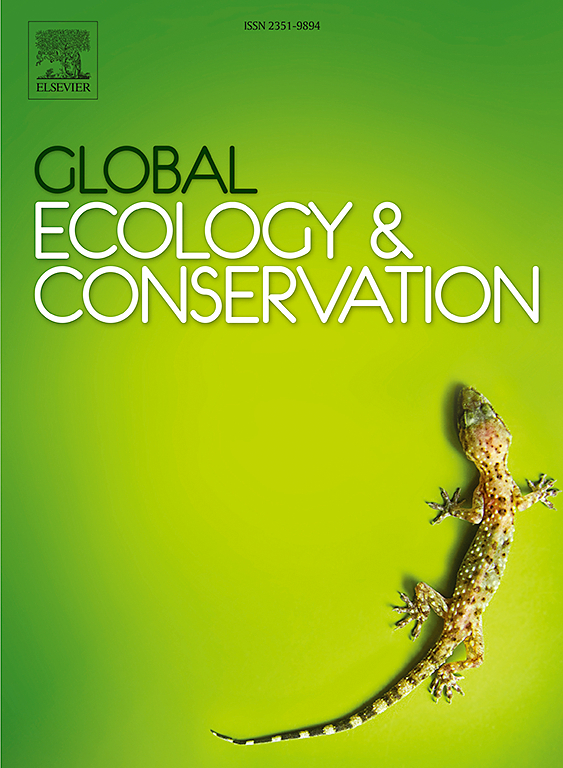Effect of invasive plant species coverage on the occurrence of wild ungulates
IF 3.4
2区 环境科学与生态学
Q1 BIODIVERSITY CONSERVATION
引用次数: 0
Abstract
The spread of invasive plant species (IPS) is widely recognized as one of the major threats to biodiversity. However, the impact of IPS on wildlife habitat utilization remains poorly understood. This study investigated the impact of IPS on the habitat utilization of wild ungulates in Parsa National Park (PNP) of Nepal. We used camera traps and sign survey methods to detect wild ungulates between December 2022 and October 2023. In each survey plot, we also recorded the occurrence and coverage of IPS, tree canopy cover, and the distances to the nearest settlement, road, and water source. Twenty IPS were recorded in the PNP during this study. Our results revealed that the barking deer were more prevalent at sites with lower IPS coverage (β = −0.065; p = 0.009), while the sambar deer were more prevalent at sies with higher IPS coverage (β = 0.053; p = 0.019) and at low tree canopy cover (β = −0.078; p = 0.008). The habitat use of barking deer was found to be higher closer to roads (β = −0.641; p = 0.004), while the sambar deer were found far from settlements (β = 0.953; p = 0.021). These results highlight the importance of managing wild ungulate habitats by controlling IPS in the PNP to conserve wild ungulate species.
入侵植物物种覆盖度对野生有蹄类动物发生的影响
植物入侵物种的扩散是生物多样性面临的主要威胁之一。然而,IPS对野生动物栖息地利用的影响仍然知之甚少。本研究调查了尼泊尔Parsa国家公园(PNP)内IPS对野生有蹄类动物栖息地利用的影响。在2022年12月至2023年10月期间,我们使用相机陷阱和指示牌调查方法来检测野生有蹄类动物。在每个样地,我们还记录了IPS的发生、覆盖、树冠覆盖度以及到最近居民点、道路和水源的距离。本研究在PNP中记录了20例IPS。结果表明,在IPS覆盖度较低的生境中,吠鹿更为常见(β = - 0.065;p = 0.009),而在IPS盖度较高的区域,沙鹿更常见(β = 0.053;P = 0.019)和低树冠覆盖度(β =−0.078; = 0.008页)。在靠近道路的地方,吠鹿的生境利用率较高(β = - 0.641;P = 0.004),而鹿群分布在远离聚落的地方(β = 0.953; = 0.021页)。这些结果强调了通过控制PNP的IPS来管理野生有蹄类动物栖息地以保护野生有蹄类物种的重要性。
本文章由计算机程序翻译,如有差异,请以英文原文为准。
求助全文
约1分钟内获得全文
求助全文
来源期刊

Global Ecology and Conservation
Agricultural and Biological Sciences-Ecology, Evolution, Behavior and Systematics
CiteScore
8.10
自引率
5.00%
发文量
346
审稿时长
83 days
期刊介绍:
Global Ecology and Conservation is a peer-reviewed, open-access journal covering all sub-disciplines of ecological and conservation science: from theory to practice, from molecules to ecosystems, from regional to global. The fields covered include: organismal, population, community, and ecosystem ecology; physiological, evolutionary, and behavioral ecology; and conservation science.
 求助内容:
求助内容: 应助结果提醒方式:
应助结果提醒方式:


